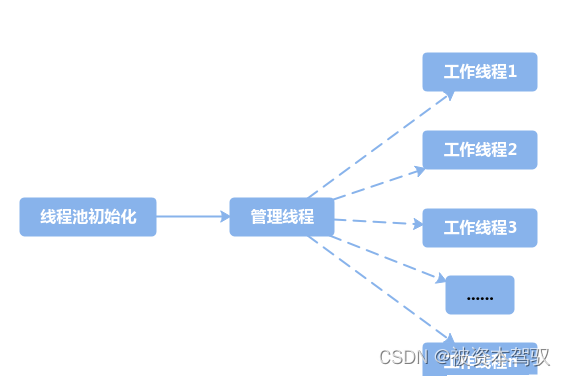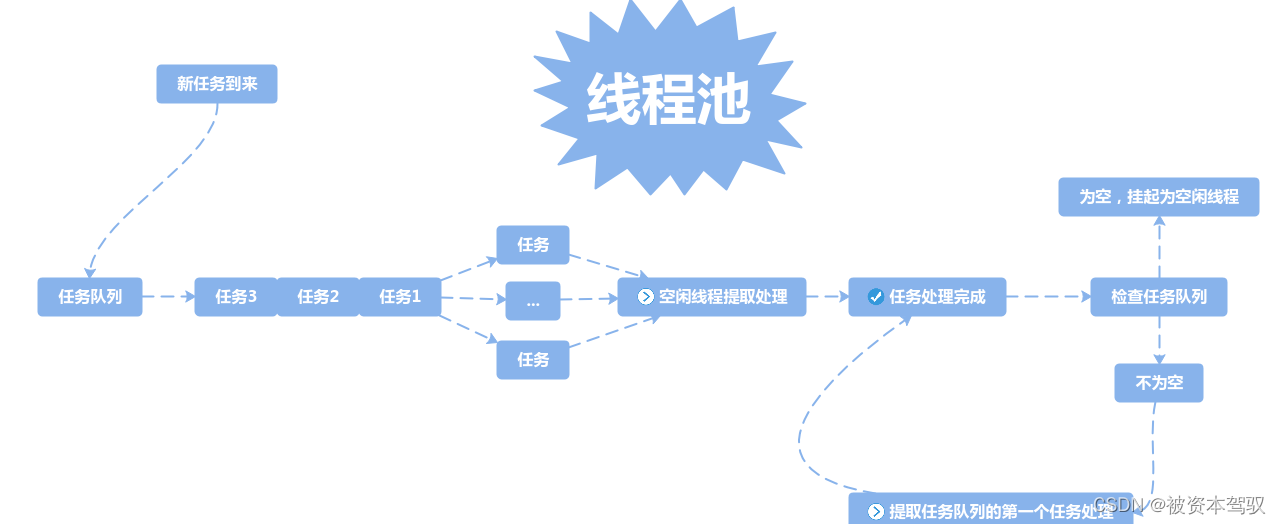什么是线程池
一种线程使用模式。线程过多会带来调度开销,进而影响缓存局部性和整体性能。而线程池维护着多个线程,等待着监督管理者分配可并发执行的任务。这避免了在处理短时间任务时创建与销毁线程的代价。线程池不仅能够保证内核的充分利用,还能防止过分调度。可用线程数量应该取决于可用的并发处理器、处理器内核、内存、网络sockets等的数量。
为什么线程池会出现,解决什么问题?
C++线程池(ThreadPool)的出现主要是为了解决以下几个问题:
1.性能:创建和销毁线程都是相对昂贵的操作,特别是在高并发场景下,频繁地创建和销毁线程会极大地降低程序的性能。通过线程池预先创建一定数量的线程并保存在内存中,可以避免频繁地创建和销毁线程,从而提高程序的性能。
2.资源管理:线程是操作系统级别的资源,如果线程数量过多,可能会导致系统资源的过度消耗,甚至可能导致系统崩溃。通过线程池,可以控制同时运行的线程数量,避免资源过度消耗。
3.任务调度:线程池可以更方便地进行任务的调度。通过线程池,可以将任务分配给不同的线程执行,实现并行处理,提高程序的执行效率。
4.简化编程:使用线程池可以简化多线程编程的复杂性。程序员只需要将任务提交给线程池,而不需要关心线程的创建、管理和销毁等细节,降低了多线程编程的难度。
因此,C++线程池的出现是为了解决在高并发场景下创建和销毁线程的开销问题,提高程序的性能和并发处理能力,简化多线程编程的复杂性
线程池的应用场景
- 需要大量的线程来完成任务,且完成任务的时间比较短。 WEB服务器完成网页请求这样的任务,使用线程池技术是非常合适的。因为单个任务小,而任务数量巨大,你可以想象一个热门网站的点击次数。 但对于长时间的任务,比如一个Telnet连接请求,线程池的优点就不明显了。因为Telnet会话时间比线程的创建时间大多了。
- 对性能要求苛刻的应用,比如要求服务器迅速响应客户请求。
- 接受突发性的大量请求,但不至于使服务器因此产生大量线程的应用。突发性大量客户请求,在没有线程池情况下,将产生大量线程,虽然理论上大部分操作系统线程数目最大值不是问题,短时间内产生大量线程可能使内存到达极限,出现错误.
简单解释下原理
线程池初始化时,初始化线程,也可以生成一个管理线程,来管理工作线线程数量。
如果当前任务队列一直有很多任务时,说明线程繁忙,处理不过来,可以根据设置的最大工作线程数来新增线程,提高并发处理能力,提高工作效率。
如果当前任务队列一直为空,说明当前时间段,没有任务或者很少的任务要处理,可以销毁多余的空闲线程,避免资源浪费。

初始化线程池后,有新任务到来后,线程池处理流程为:
将新任务投递到线程队列中->发送信号通知线程处理->空闲线程处理->处理完成检查任务队列是否还有任务->有任务则提取任务处理,没有任务就挂起为空闲线程,避免占用系统资源
如下图所示:

// thread.hpp
#pragma once
#include <iostream>
#include <pthread.h>
#include <string>
#include <cstdio>
typedef void*(*func_t)(void*);
class threadData
{
public:
void* args_;
std::string name_;
};
class thread
{
public:
thread(int num,func_t callback,void * args)
:func_(callback)
{
char namebuf[64];
snprintf(namebuf,sizeof namebuf,"thread - %d",num);
name_ = namebuf;
tdata_.name_ = name_;
tdata_.args_ = args;
}
void start()
{
pthread_create(&tid_,nullptr,func_,(void*)&tdata_);
}
void join()
{
pthread_join(tid_,nullptr);
}
std::string name()
{
return tdata_.name_;
}
~thread()
{
}
private:
pthread_t tid_;
threadData tdata_;
std::string name_;
func_t func_;
};
// threadPool.hpp
#pragma once
#include <iostream>
#include <vector>
#include <string>
#include <queue>
#include <unistd.h>
#include "thread.hpp"
#include "lockGuard.hpp"
#include "log.hpp"
const int g_thread_num = 3;
// 本质是: 生产消费模型
template <class T>
class ThreadPool
{
public:
pthread_mutex_t *getMutex()
{
return &lock;
}
bool isEmpty()
{
return task_queue_.empty();
}
void waitCond()
{
pthread_cond_wait(&cond, &lock);
}
T getTask()
{
T t = task_queue_.front();
task_queue_.pop();
return t;
}
private:
ThreadPool(int thread_num = g_thread_num) : num_(thread_num)
{
pthread_mutex_init(&lock, nullptr);
pthread_cond_init(&cond, nullptr);
for (int i = 1; i <= num_; i++)
{
threads_.push_back(new thread(i, routine, this));
}
}
ThreadPool(const ThreadPool<T> &other) = delete;
const ThreadPool<T> &operator=(const ThreadPool<T> &other) = delete;
public:
// 考虑一下多线程使用单例的过程
// 类内成员方法也无法访问静态成员,单例要把构造设为私有
static ThreadPool<T> *getThreadPool(int num = g_thread_num)
{
// 可以有效减少未来必定要进行加锁检测的问题
// 拦截大量的在已经创建好单例的时候,剩余线程请求单例的而直接访问锁的行为
if (nullptr == thread_ptr)
{
lockGuard lockguard(&mutex);
// 但是,未来任何一个线程想获取单例,都必须调用getThreadPool接口
// 但是,一定会存在大量的申请和释放锁的行为,这个是无用且浪费资源的
// pthread_mutex_lock(&mutex);
if (nullptr == thread_ptr)
{
thread_ptr = new ThreadPool<T>(num);
}
// pthread_mutex_unlock(&mutex);
}
return thread_ptr;
}
// 1. run()
void run()
{
for (auto &iter : threads_)
{
iter->start();
// std::cout << iter->name() << " 启动成功" << std::endl;
logMessage(NORMAL, "%s %s", iter->name().c_str(), "启动成功");
}
}
// 线程池本质也是一个生产消费模型
// void *routine(void *args)
// 消费过程
static void *routine(void *args) // 静态成员函数无法访问类内成员,所以传this指针
{
ThreadData *td = (ThreadData *)args;
ThreadPool<T> *tp = (ThreadPool<T> *)td->args_;
while (true)
{
T task;
{
lockGuard lockguard(tp->getMutex());
while (tp->isEmpty())
tp->waitCond();
// 读取任务
task = tp->getTask(); // 任务队列是共享的-> 将任务从共享,拿到自己的私有空间
}// 花括号相当于一个代码块,进入代码块加锁出代码块解锁
task(td->name_);// 处理任务
// lock
// while(task_queue_.empty()) wait();
// 获取任务
// unlock
// 处理任务
}
}
// 2. pushTask() 生产过程
void pushTask(const T &task)
{
lockGuard lockguard(&lock);
task_queue_.push(task);
pthread_cond_signal(&cond);
}
// test func
// void joins()
// {
// for (auto &iter : threads_)
// {
// iter->join();
// }
// }
~ThreadPool()
{
for (auto &iter : threads_)
{
iter->join();
delete iter;
}
pthread_mutex_destroy(&lock);
pthread_cond_destroy(&cond);
}
private:
std::vector<thread *> threads_;
int num_;
std::queue<T> task_queue_;
static ThreadPool<T> *thread_ptr;
static pthread_mutex_t mutex;
// 方案2:
// queue1,queue2
// std::queue<T> *p_queue, *c_queue
// p_queue->queue1
// c_queue->queue2
// p_queue -> 生产一批任务之后,swap(p_queue,c_queue),把指针进行交换,唤醒所有线程/一个线程
// 当消费者处理完毕的时候,你也可以进行swap(p_queue,c_queue)
// 因为我们生产和消费用的是不同的队列,未来我们要进行资源的处理的时候,仅仅是指针
pthread_mutex_t lock;
pthread_cond_t cond;
};
template <typename T>
ThreadPool<T> *ThreadPool<T>::thread_ptr = nullptr;
template <typename T>
pthread_mutex_t ThreadPool<T>::mutex = PTHREAD_MUTEX_INITIALIZER;
// testMain.cc
#include "threadPool.hpp"
#include "Task.hpp"
#include <ctime>
#include <cstdlib>
#include <iostream>
#include <unistd.h>
// void *run(void *args)
// {
// while(true)
// {
// ThreadPool<Task>::getThreadPool();
// }
// }
int main()
{
// logMessage(NORMAL, "%s %d %c %f \n", "这是一条日志信息", 1234, 'c', 3.14);
srand((unsigned long)time(nullptr) ^ getpid());
// ThreadPool<Task> *tp = new ThreadPool<Task>();
// ThreadPool<Task> *tp = ThreadPool<Task>::getThreadPool();
// 那么,如果单例本身也在被多线程申请使用呢??
ThreadPool<Task>::getThreadPool()->run();
//thread1,2,3,4
while(true)
{
//生产的过程,制作任务的时候,要花时间
int x = rand()%100 + 1;
usleep(7721);
int y = rand()%30 + 1;
Task t(x, y, [](int x, int y)->int{
return x + y;
});
// std::cout << "制作任务完成: " << x << "+" << y << "=?" << std::endl;
logMessage(DEBUG, "制作任务完成: %d+%d=?", x, y);
logMessage(DEBUG, "制作任务完成: %d+%d=?", x, y);
logMessage(DEBUG, "制作任务完成: %d+%d=?", x, y);
logMessage(DEBUG, "制作任务完成: %d+%d=?", x, y);
// 推送任务到线程池中
ThreadPool<Task>::getThreadPool()->pushTask(t);
sleep(1);
}
return 0;
}
// Tash.hpp
#pragma once
#include <iostream>
#include <string>
#include <functional>
#include "log.hpp"
typedef std::function<int(int, int)> func__t;
class Task
{
public:
Task(){}
Task(int x, int y, func__t func):x_(x), y_(y), func_(func)
{}
void operator ()(const std::string &name)
{
//std::cout << "线程 " << name << " 处理完成, 结果是: " << x_ << "+" << y_ << "=" << func_(x_, y_) << std::endl;
logMessage(WARNING, "%s处理完成: %d+%d=%d | %s | %d",
name.c_str(), x_, y_, func_(x_, y_), __FILE__, __LINE__);
}
public:
int x_;
int y_;
// int type;
func__t func_;
};






















 599
599

 被折叠的 条评论
为什么被折叠?
被折叠的 条评论
为什么被折叠?








